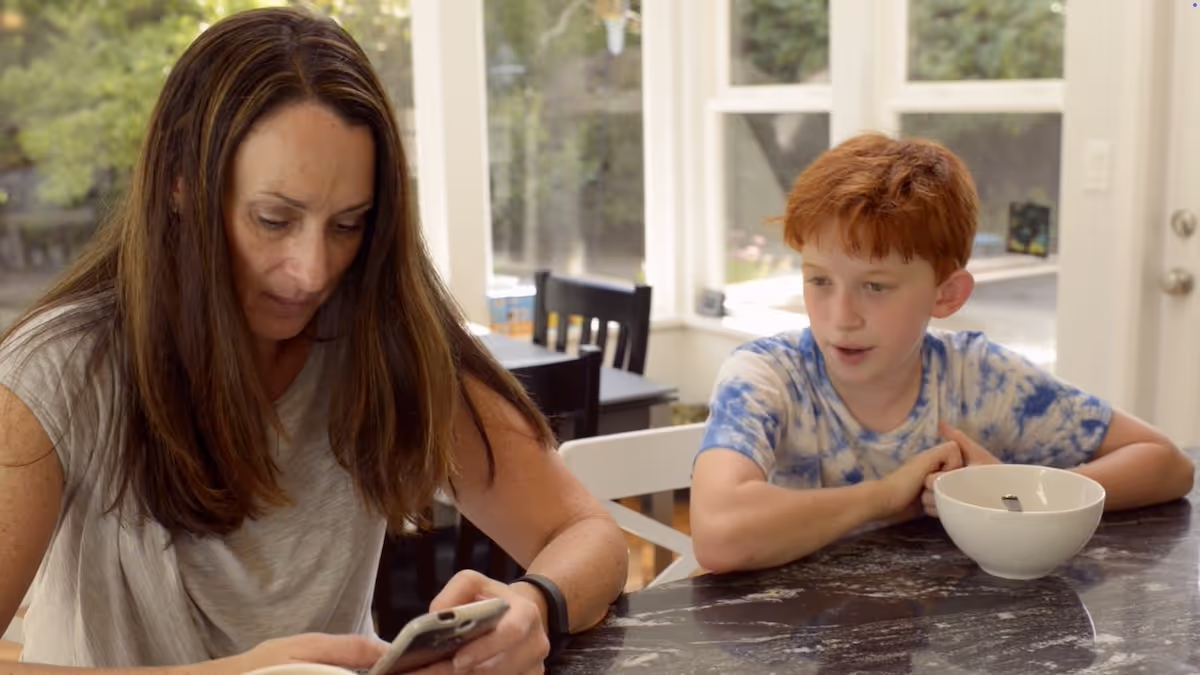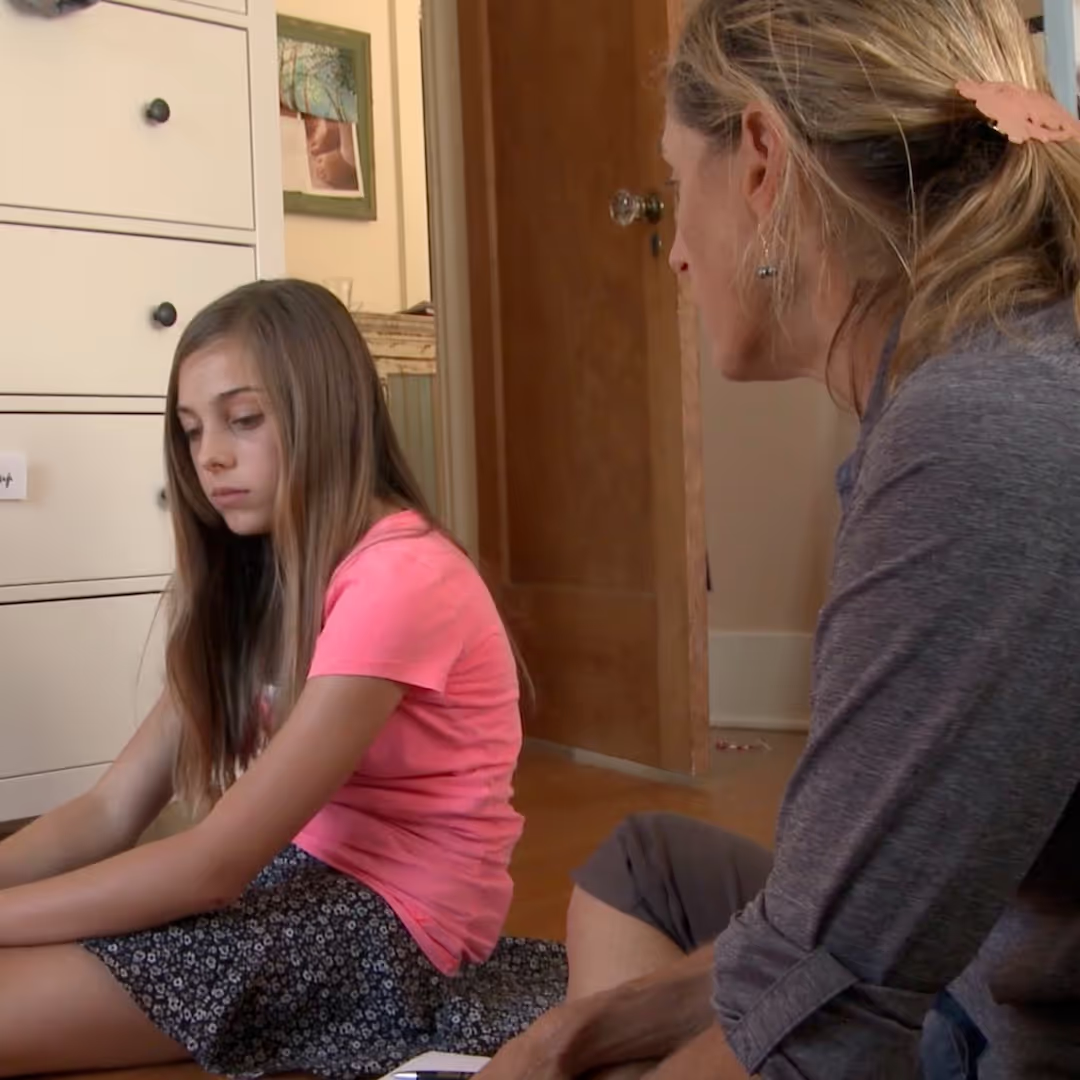


In 2016, when actress Jennifer Lawrence was talking to the press after winning a Golden Globe for her performance in the movie “Joy,” she told a reporter to put their phone away. “You can’t live your whole life behind your phone, bro,” she told the reporter while waving her finger. “You can’t do that, you know, you have to live in the now,” she continued. The reporter responded by saying, “sorry, sorry, sorry.”
Studies have shown that the mere presence of a cell phone puts our brains on alert for potential distractions, making cognitive functioning, and connecting in person difficult. So why aren’t we asking people more often to give us their full attention and put the phone away?
Let’s talk about the art of asking people to put their phone away. The way you approach the ask is key to its effectiveness. I have asked dozens of middle and high schoolers whether they ever ask friends to put their phones away. About 80% of them tell me they have. When I inquire about their tactic, many say what works them is to just be straight forward and say something like “Hey, can you put please your phone away.” A couple of people have said that they don’t ask but instead leave the room, hoping the person will get the clue.
Often youth are together looking at YouTube videos, and when that is happening they tend not to ask for phones to be put away. But, when one or many of the friends are clearly just communicating with someone else via their phone, is the time when someone is more likely to ask for phones to be put away.
Adults seem to ask this much less often but clearly, there are times when a direct ask, or a little nudge, can be helpful to the situation at hand. My teen daughter, Tessa, and I were talking today about how people ask for phones to be put away. Then, later in the day, I was driving her somewhere, and she was checking her phone, and I said “Hey, what are you doing?” because she knows we have a no-phone-in-the-car rule. She laughed and said, “That’s how you always ask me to put my phone away — ”Hey, what are you doing?” She was right, that is often my go-to for the family.
But let’s think of situations not involving our family members such as trying to have a conversation with a friend at school or friend at work who are clearly having a long conversation or other preoccupation on the phone.
One helpful approach is to try to get ahead of the situation. In Screenagers there is a scene where a group of teenagers is out at a restaurant, and they all put their phones in the middle of the table and the first one to check their phone pays the bill. How about trying this with your family but the first one to check it has to do the dishes?
Elaine Giolando, who writes for Fast Company, not long ago decided enough was enough and began asking people to put their phones down. “It’s an experiment in doing something pretty unthinkable these days: asking for someone’s full attention,” she writes in the article. “It takes some vulnerability to speak up, but I’ve found it’s also provoked worthwhile conversations about the importance of being present.”
Undistracted presence fosters connection and trust in a relationship. There is nothing wrong with asking the person you are with to put the phone down. But how we do it is important.
Vacation, Time to Unplug?
Ways to Manager Screen Time this Summer
Vacation from Notifications
We would love for you to share this TTT any way that works for you, whether that’s on social media or via a newsletter. If you want to send it out in your newsletter we just ask that you credit us and link to our website, and let us know at lisa@screenagersmovie.com.
HOST A SCREENING to help spark change.
FIND EVENT LISTINGS
Do you organize professional development in schools? We now have a 6-hour, 3-part training module. Request more information here Professional Development.
Stay in touch with the Screenagers community on Facebook, Twitter and leave comments below.
Learn more about showing our movies in your school or community!
Join Screenagers filmmaker Delaney Ruston MD for our latest Podcast

Learn more about our Screen-Free Sleep campaign at the website!
Our movie made for parents and educators of younger kids
Learn more about showing our movies in your school or community!
Learn more about showing our movies in your school or community!
Join Screenagers filmmaker Delaney Ruston MD for our latest Podcast

Learn more about our Screen-Free Sleep campaign at the website!
Our movie made for parents and educators of younger kids
Join Screenagers filmmaker Delaney Ruston MD for our latest Podcast
As we’re about to celebrate 10 years of Screenagers, we want to hear what’s been most helpful and what you’d like to see next.
Please click here to share your thoughts with us in our community survey. It only takes 5–10 minutes, and everyone who completes it will be entered to win one of five $50 Amazon vouchers.
In 2016, when actress Jennifer Lawrence was talking to the press after winning a Golden Globe for her performance in the movie “Joy,” she told a reporter to put their phone away. “You can’t live your whole life behind your phone, bro,” she told the reporter while waving her finger. “You can’t do that, you know, you have to live in the now,” she continued. The reporter responded by saying, “sorry, sorry, sorry.”
Studies have shown that the mere presence of a cell phone puts our brains on alert for potential distractions, making cognitive functioning, and connecting in person difficult. So why aren’t we asking people more often to give us their full attention and put the phone away?
Let’s talk about the art of asking people to put their phone away. The way you approach the ask is key to its effectiveness. I have asked dozens of middle and high schoolers whether they ever ask friends to put their phones away. About 80% of them tell me they have. When I inquire about their tactic, many say what works them is to just be straight forward and say something like “Hey, can you put please your phone away.” A couple of people have said that they don’t ask but instead leave the room, hoping the person will get the clue.
Often youth are together looking at YouTube videos, and when that is happening they tend not to ask for phones to be put away. But, when one or many of the friends are clearly just communicating with someone else via their phone, is the time when someone is more likely to ask for phones to be put away.
Adults seem to ask this much less often but clearly, there are times when a direct ask, or a little nudge, can be helpful to the situation at hand. My teen daughter, Tessa, and I were talking today about how people ask for phones to be put away. Then, later in the day, I was driving her somewhere, and she was checking her phone, and I said “Hey, what are you doing?” because she knows we have a no-phone-in-the-car rule. She laughed and said, “That’s how you always ask me to put my phone away — ”Hey, what are you doing?” She was right, that is often my go-to for the family.
But let’s think of situations not involving our family members such as trying to have a conversation with a friend at school or friend at work who are clearly having a long conversation or other preoccupation on the phone.
One helpful approach is to try to get ahead of the situation. In Screenagers there is a scene where a group of teenagers is out at a restaurant, and they all put their phones in the middle of the table and the first one to check their phone pays the bill. How about trying this with your family but the first one to check it has to do the dishes?
Elaine Giolando, who writes for Fast Company, not long ago decided enough was enough and began asking people to put their phones down. “It’s an experiment in doing something pretty unthinkable these days: asking for someone’s full attention,” she writes in the article. “It takes some vulnerability to speak up, but I’ve found it’s also provoked worthwhile conversations about the importance of being present.”
Undistracted presence fosters connection and trust in a relationship. There is nothing wrong with asking the person you are with to put the phone down. But how we do it is important.
Vacation, Time to Unplug?
Ways to Manager Screen Time this Summer
Vacation from Notifications
We would love for you to share this TTT any way that works for you, whether that’s on social media or via a newsletter. If you want to send it out in your newsletter we just ask that you credit us and link to our website, and let us know at lisa@screenagersmovie.com.
HOST A SCREENING to help spark change.
FIND EVENT LISTINGS
Do you organize professional development in schools? We now have a 6-hour, 3-part training module. Request more information here Professional Development.
Stay in touch with the Screenagers community on Facebook, Twitter and leave comments below.
Sign up here to receive the weekly Tech Talk Tuesdays newsletter from Screenagers filmmaker Delaney Ruston MD.
We respect your privacy.
In 2016, when actress Jennifer Lawrence was talking to the press after winning a Golden Globe for her performance in the movie “Joy,” she told a reporter to put their phone away. “You can’t live your whole life behind your phone, bro,” she told the reporter while waving her finger. “You can’t do that, you know, you have to live in the now,” she continued. The reporter responded by saying, “sorry, sorry, sorry.”
Studies have shown that the mere presence of a cell phone puts our brains on alert for potential distractions, making cognitive functioning, and connecting in person difficult. So why aren’t we asking people more often to give us their full attention and put the phone away?
Let’s talk about the art of asking people to put their phone away. The way you approach the ask is key to its effectiveness. I have asked dozens of middle and high schoolers whether they ever ask friends to put their phones away. About 80% of them tell me they have. When I inquire about their tactic, many say what works them is to just be straight forward and say something like “Hey, can you put please your phone away.” A couple of people have said that they don’t ask but instead leave the room, hoping the person will get the clue.
Often youth are together looking at YouTube videos, and when that is happening they tend not to ask for phones to be put away. But, when one or many of the friends are clearly just communicating with someone else via their phone, is the time when someone is more likely to ask for phones to be put away.
Adults seem to ask this much less often but clearly, there are times when a direct ask, or a little nudge, can be helpful to the situation at hand. My teen daughter, Tessa, and I were talking today about how people ask for phones to be put away. Then, later in the day, I was driving her somewhere, and she was checking her phone, and I said “Hey, what are you doing?” because she knows we have a no-phone-in-the-car rule. She laughed and said, “That’s how you always ask me to put my phone away — ”Hey, what are you doing?” She was right, that is often my go-to for the family.
But let’s think of situations not involving our family members such as trying to have a conversation with a friend at school or friend at work who are clearly having a long conversation or other preoccupation on the phone.
One helpful approach is to try to get ahead of the situation. In Screenagers there is a scene where a group of teenagers is out at a restaurant, and they all put their phones in the middle of the table and the first one to check their phone pays the bill. How about trying this with your family but the first one to check it has to do the dishes?
Elaine Giolando, who writes for Fast Company, not long ago decided enough was enough and began asking people to put their phones down. “It’s an experiment in doing something pretty unthinkable these days: asking for someone’s full attention,” she writes in the article. “It takes some vulnerability to speak up, but I’ve found it’s also provoked worthwhile conversations about the importance of being present.”
Undistracted presence fosters connection and trust in a relationship. There is nothing wrong with asking the person you are with to put the phone down. But how we do it is important.
Vacation, Time to Unplug?
Ways to Manager Screen Time this Summer
Vacation from Notifications
We would love for you to share this TTT any way that works for you, whether that’s on social media or via a newsletter. If you want to send it out in your newsletter we just ask that you credit us and link to our website, and let us know at lisa@screenagersmovie.com.
HOST A SCREENING to help spark change.
FIND EVENT LISTINGS
Do you organize professional development in schools? We now have a 6-hour, 3-part training module. Request more information here Professional Development.
Stay in touch with the Screenagers community on Facebook, Twitter and leave comments below.

Psychologist Jean Twenge explains how parental controls can support healthier tech use by protecting sleep, limiting late night device access, and reducing kids’ exposure to content they are not developmentally ready to handle. She discusses why third party parental control tools are often more effective and easier to use than built in options, while acknowledging that no system is perfect. Clear boundaries, combined with technology based limits, can reduce ongoing conflict and make screen time rules easier to enforce.
READ MORE >

Parenting in this digital age is full of challenges. I imagine many of you are nodding in agreement. And when we look for advice online, it can feel like a sea of perfect experts with perfect advice: “Just follow these three easy steps and everything will fall into place.” In this week’s blog, I share a story about a moment with my daughter Tessa that did not go quite as planned but ended up teaching us both something important.
READ MORE >for more like this, DR. DELANEY RUSTON'S NEW BOOK, PARENTING IN THE SCREEN AGE, IS THE DEFINITIVE GUIDE FOR TODAY’S PARENTS. WITH INSIGHTS ON SCREEN TIME FROM RESEARCHERS, INPUT FROM KIDS & TEENS, THIS BOOK IS PACKED WITH SOLUTIONS FOR HOW TO START AND SUSTAIN PRODUCTIVE FAMILY TALKS ABOUT TECHNOLOGY AND IT’S IMPACT ON OUR MENTAL WELLBEING.
